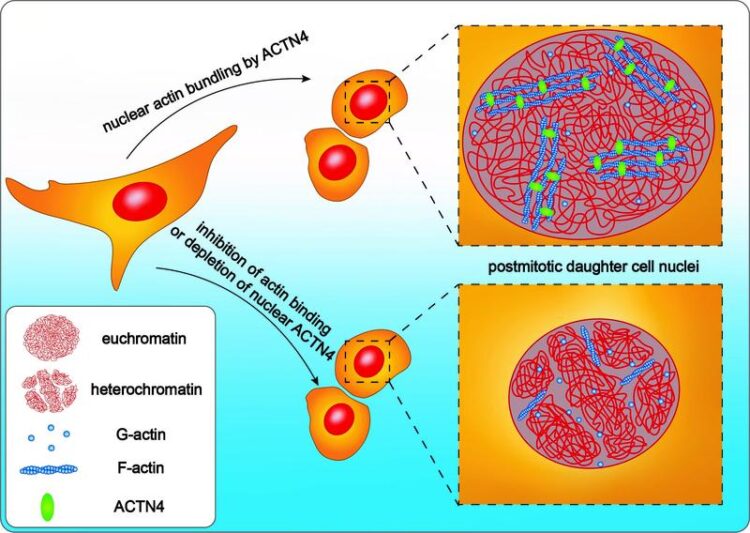Researchers discover a mechanism that causes cell nuclei to grow

Two cell nuclei after division: At the top, fibers of actin are bundled with the aid of the protein Alpha-Actinin 4 (ACTN4) in the nucleus. Below, ACTN4 is inhibited or entirely absent.
Graphic: Robert Grosse/Ulrike Endesfelder
By far the most important process in cell development is how cells divide and then enlarge in order to multiply. A research team headed by Freiburg medical scientist Prof. Dr. Robert Grosse has now discovered that bundled fibers of actin within a cell nucleus play an important part in how they enlarge after division.
Fibers of the structural protein actin stabilize the outer form of the cell and transport substances into a cell. The mechanisms that influence the growth of the cell nucleus after division were less well known by scientists. The researchers have published their results in the journal ‘EMBO reports’.
After dividing, cell nuclei have to grow in order to reorganize and unpack the genetic information in chromatin, the basic genetic material, and so process and read it. With this work the scientists show that bundled fibers of actin – which are normally responsible for exercising force – work within the cell to expand the nucleus. Using a video microscope the researchers have measured in living cells how cell nuclei enlarge immediately after division. In order to observe the fibers of actin and skeletal structures in the cell nucleus, they also used a high-resolution super-resolution microscope.
In the future Grosse and his team want to clarify whether mechanical forces work within the cell nucleus to re-organize them to sort the genetic information. If so, this process could for example be disrupted or changed in tumor cells or play a part in stem cells.
Freiburg medical scientist Robert Grosse is a professor of Pharmacology and Toxicology and director of Division I at the Institute of Experimental and Clinical Pharmacology and Toxicology, as well as a member of the Cluster of Excellence CIBSS – Centre for Integrative Biological Signalling Studies at the University of Freiburg. His team is working with a group headed by Dr. Ulrike Endesfelder from the Max Planck Institute for Terrestrial Microbiology in Marburg, which is contributing expertise in super-resolution microscopy.
Original publication:
Krippner, S., Winkelmeier, J., Knerr, J., Brandt, D. T., Virant, D., Schwan, C., Endesfelder, U. & Grosse, R. (2020). Post-mitotic expansion of cell nuclei requires nuclear actin filament bundling by a-actinin 4. In EMBO reports, DOI: 10.15252/embr.202050758
Contact:
Prof. Dr. Robert Grosse
Institute of Experimental and Clinical Pharmacology and Toxicology
University of Freiburg
Tel.: +49 761 203-5301
e-mail: robert.grosse@pharmakol.uni-freiburg.de
Originalpublikation:
https://www.embopress.org/doi/full/10.15252/embr.202050758
Weitere Informationen:
https://www.pr.uni-freiburg.de/pm-en/press-releases-2020/divide-and-enlarge?set_language=en
Media Contact
All latest news from the category: Life Sciences and Chemistry
Articles and reports from the Life Sciences and chemistry area deal with applied and basic research into modern biology, chemistry and human medicine.
Valuable information can be found on a range of life sciences fields including bacteriology, biochemistry, bionics, bioinformatics, biophysics, biotechnology, genetics, geobotany, human biology, marine biology, microbiology, molecular biology, cellular biology, zoology, bioinorganic chemistry, microchemistry and environmental chemistry.
Newest articles

You are What You Eat—Stanford Study Links Fiber to Anti-Cancer Gene Modulation
The Fiber Gap: A Growing Concern in American Diets Fiber is well known to be an important part of a healthy diet, yet less than 10% of Americans eat the minimum recommended…

Trust Your Gut—RNA-Protein Discovery for Better Immunity
HIRI researchers uncover control mechanisms of polysaccharide utilization in Bacteroides thetaiotaomicron. Researchers at the Helmholtz Institute for RNA-based Infection Research (HIRI) and the Julius-Maximilians-Universität (JMU) in Würzburg have identified a…

ASXL1 Mutation: The Hidden Trigger Behind Blood Cancers and Inflammation
Scientists show how a mutated gene harms red and white blood cells. LA JOLLA, CA—Scientists at La Jolla Institute for Immunology (LJI) have discovered how a mutated gene kicks off…



